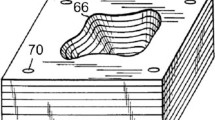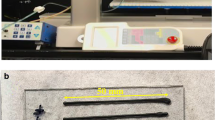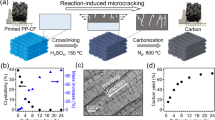Abstract
Cellular materials, metallic bodies with gaseous voids interspersed throughout the solid body, are a promising class of materials that offer high strength accompanied by a relatively low mass. Recent research has focused in the topological design of cellular materials in order to satisfy multiple design objectives. Unfortunately, these design advances have not been met with similar advances in cellular material manufacturing as existing techniques constrain a designer to a predetermined part mesostructure, material type, and macrostructure. In an effort to address these limitations, the authors have developed a manufacturing process chain centered on an augmented three-dimensional printing process. Specifically, metallic cellular materials are made by selectively printing solvent into a bed of spray-dried metal oxide ceramic powder. The resulting green part is then sintered in a reducing atmosphere to chemically convert it to metal. The resultant process has produced maraging steel cellular artifacts featuring a 270-μm wall thickness and angled trusses and channels that are less than 1 mm in diameter.
Similar content being viewed by others
References
Ashby MF, Evans AG, Fleck NA, Gibson LJ, Hutchinson JW, Wadley HNG (2000) Metal foams: a design guide. Butterworth-Heinemann, Woburn
Banhart J, Weaire D (2002) On the road again: metal foams find favor. Physics Today 55:37–42
Banhart J (2000) Manufacturing routes for metallic foams. JOM 52(12):22–27
Evans AG, Hutchinson JW, Fleck NA, Ashby MF, Wadley HNG (2001) The topological design of multifunctional cellular metals. Prog Mater Sci 46:309–327
Seepersad CC, Kumar RS, Allen JK, Mistree FM, McDowell DL (2004) Multifunctional design of prismatic cellular materials. J Comput-Aided Mater Des 11(2):163–181
Wang HV, Johnston SR, Rosen DW (2006) Design of a graded cellular structure for an acetabular hip replacement component. 17th Solid Freeform Fabrication Symposium, pp 111–123
Wang H, Rosen DW (2002) Computer-aided design methods for additive fabrication of truss structures. International Conference on Manufacturing Automation
Wadley HNG, Fleck NA, Evans A (2003) Fabrication and structural performance of periodic cellular metal sandwich structures. Compos Sci Technol 63:2331–2343
Tian J, Lu TJ, Hodson HP, Queheillalt DT, Wadley HNG (2007) Cross flow heat exchange of textile cellular metal core sandwich panels. Int J Heat Mass Transfer 50:2521–2536
Jamcorp Inc. (2004) Jonathon Aerospace Materials website. http://www.jamcorp.com. Accessed June 2007.
Wadley HNG (2002) Cellular metals manufacturing. Adv Eng Mater 4(10):726–733
Sypeck DJ, Wadley HNG (2002) Cellular metal truss core sandwich structures. Adv Eng Mater 4(10):759–764
Williams CB, Mistree F, Rosen, DW (2005) Investigation of solid freeform fabrication processes for the manufacture of parts with designed mesostructure. ASME IDETC Design for Manufacturing and the Life Cycle Conference, DETC2005/DFMLC-84832
Hattiangadi A, Bandyopadhyay A (1999) Processing, characterization and modeling of non-random porous ceramic structures. Solid Freeform Fabrication Symposium, pp 319–326
Chiras S, Mumm DR, Evans AG, Wicks N, Hutchinson JW, Dharmasena K, Wadley HNG, Fichter S (2002) The structural performance of near-optimized truss core panels. Int J Solids Struct 39:4093–4115
Solidica Inc. (2004) Solidica: direct to metal aluminum tooling for advanced manufacturing. http://www.solidica.com/technology.html. Accessed June 2007.
Robinson CJ, Zhang C, Janaki Ram GD, Siggard EJ, Stucker B, Li L (2007) Maximum height to width ratio of freestanding structures built using ultrasonic consolidation. Solid Freeform Fabrication Symposium, pp 502–516
Pham DT, Dimov SS, Ji C, Gault RS (2003) Layer manufacturing processes: technology advances and research challenges. 1st International Conference on Advanced Research in Virtual and Rapid Prototyping, pp 107–113
Brooks W, Sutcliffe C, Cantwell W, Fox P, Todd J, Mines R (2005) Rapid design and manufacture of ultralight cellular materials. 16th Solid Freeform Fabrication Symposium, pp 231–241
Agarwala M, Bourell D, Beaman J, Marcus H, Barlow J (1995) Direct selective laser sintering of metals. Rapid Prototyping J 1(1):26–36
Cansizoglu O, Cormier D, Harrysson O, West H, Mahale T (2006) An evaluation of non-stochastic lattice structures fabricateed via electron beam melting. Solid Freeform Fabrication, pp. 209–2119
Kruth JP, Froyen L, Van Vaerenbergh J, Mercelis P, Rombouts M, Lauwers B (2004) Selective laser melting of iron-based powder. J Mater Process Technol 149(1–3):616–622
Cormier D, Harrysson O, West H (2004) Characterization of H13 steel produced via electron beam melting. Rapid Prototyping J 10(1):35–41
Rice CS, Mendez PF, Brown SB (2000) Metal solid freeform fabrication using semi-solid slurries. JOM 52(12):31–33. doi:10.1007/s11837-000-0065-5
Kruth JP, Mercelis P, Van Vaerenbergh J, Craeghs T (2007) Feedback control of selective laser melting. Advanced research in virtual and rapid prototyping, pp 521–527
Rehme O, Emmelmann C, Schwarze D (2007) Selective laser melting of lattice structures in solid shells. Advanced research in virtual and rapid prototyping, pp 529–535
Cochran JK, Lee KJ, McDowell DL, Sanders TH (2002) Multifunctional metallic honeycombs by thermal chemical processing. Processing and properties of lightweight cellular metals and structures (TMS), pp 127–136
Cochran JK, Lee KJ, Sanders TH (2003) Metallic articles formed by reduction of nonmetallic articles and method of producing metallic articles. US 6582651 B1, USA, Georgia Tech Research Corporation
Cochran JK, Lee KJ, McDowell D, Sanders TH, Church B, Clark J, Dempsey B, Hurysz K, McCoy T, Nadler J, Oh R, Seay W, Shapiro B (2000) Low density monolithic metal honeycombs by thermal chemical processing. Fourth Conference on Aerospace Materials, Processes, and Environmental Technology
Williams CB, Mistree F, Rosen DW (2005) Towards the Design of a layer-based additive manufacturing process for the realization of metal parts of designed mesostructure. 16th Solid Freeform Fabrication Symposium, pp 217–230
Williams CB, Mistree F, Rosen DW (2008) The Systematic Design of a Layered Manufacturing Process for the Realization of Metal Parts of Designed Mesostructure. 5th ASME Symposium on International Design and Design Education, DETC2004/DEC-49457
Williams CB, Rosen DW (2007) Manufacturing cellular materials via three-dimensional printing of spray-dried metal oxide ceramic powder. 3rd International Conference on Advanced Research in Virtual and Rapid Prototyping
Sachs EM, Haggerty JS, Cima MJ, Williams PA (1993) Three-dimensional printing techniques. US patent 5 204 055, Massachusetts Institute of Technology
Carrion A (1997) technology forecast on ink-jet head technology applications in rapid prototyping. Rapid Prototyping J 3(3):99–115
Agarwala MK, Jamalabad VR, Langrana NA, Safari A, Whalen PJ, Danforth SC (1996) Structural quality of parts processed by fused deposition. Rapid Prototyping J 2(4):4–19
Wright MJ, Evans JRG (1999) Ceramic deposition using an electromagnetic jet printer station. J Mater Sci Lett 18:99–101
Seerden KAM, Reis N, Evans JRG, Grant PS, Halloran JW, Derby B (2001) Ink-jet printing of wax-based alumina suspensions. J Am Ceram Soc 84(11):2514–2520
Lewis JA (2000) Colloidal processing of ceramics. J Am Ceram Soc 83(10):2341–2359
Griffith ML, Halloran JW (1996) Freeform fabrication of ceramics via stereolithography. J Am Ceram Soc 79(10):2601–2608
Grida I, Evans JRG (2003) Extrusion freeforming of ceramics through fine nozzles. J Eur Ceram Soc 23:629–635
Utela B, Anderson RL, Kuhn H (2006) Advanced ceramic materials and three-dimensional printing (3DP). 17th Solid Freeform Fabrication Symposium, pp 290–303
Sachs E, Cima MJ, Cornie J, Brancazio D, Bredt J, Curodeau A, Fan T, Khanuja S, Lauder A, Lee J, Michaels S (1993) Three-dimensional printing: the physics and implications of additive manufacturing. CIRP Ann 42(1):257–260
Yoo, J, Cima MJ, Khanuja S, Sachs EM (1993) Structural ceramic components by 3D printing. Solid Freeform Fabrication Symposium, pp 40–50
Reed JS (1995) Principles of ceramics processing. John Wiley & Sons, Inc, New York
Cima, MJ, Yoo J, Khanuja S, Rynerson M, Nammour D, Giritlioglu B, Grau J, Sachs EM (1995) Structural ceramic components by 3D printing. Solid Freeform Fabrication Symposium, pp 479–488
Cima MJ, Lauder A, Khanuja S, Sachs EM (1992) Microstructural elements of components derived from 3D printing. Solid Freeform Fabrication Symposium, pp 220–227
Morse T (1979) Handbook of organic additives for use in ceramic body formulation. Montana Energy and MHD Research and Development Institute, Butte
Z Corporation (2007) 3D printers. http://www.zcorp.com/Products/3D-Printers/spage.aspx. Accessed 5 November 2007
Williams CB (2008) Design and development of a layer-based additive manufacturing process for the realization of metal parts of designed mesostructure. Dissertation, Georgia Institute of Technology
Author information
Authors and Affiliations
Corresponding author
Rights and permissions
About this article
Cite this article
Williams, C.B., Cochran, J.K. & Rosen, D.W. Additive manufacturing of metallic cellular materials via three-dimensional printing. Int J Adv Manuf Technol 53, 231–239 (2011). https://doi.org/10.1007/s00170-010-2812-2
Received:
Accepted:
Published:
Issue Date:
DOI: https://doi.org/10.1007/s00170-010-2812-2




